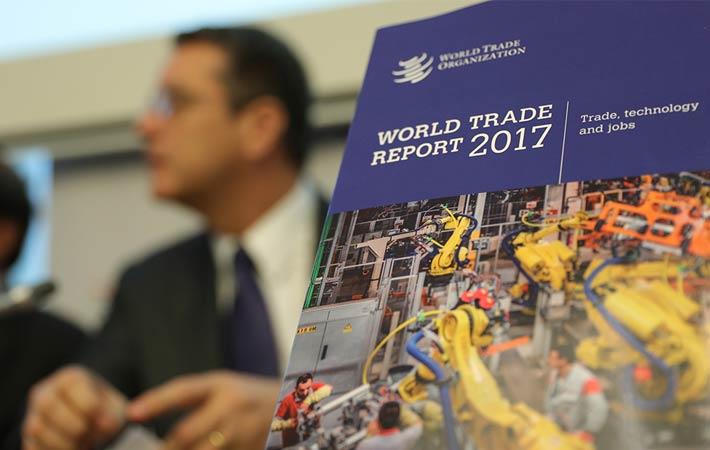Govts must find answers to domestic labour issues: WTO

A failure to find answers to domestic policy shortcomings that are responsible for today's labour market problems at the local levels could lead to global ramifications, the World Trade Organization (WTO) has warned.
Governments will therefore need to meet, talk and negotiate, and arrive at cooperative “win-win” approaches to the opportunities, as well as the challenges, of ongoing global economic change, the WTO's World Trade Report 2017: Trade, technology and jobs has remarked.
The 2017 World Trade Report, the flagship publication of the WTO, examines how technology and trade affect employment and wages. It analyses the challenges for workers and firms in adjusting to changes in labour markets, and how governments can facilitate such adjustment to increase the positive impact of open trade and technological progress.
Setting the tone for the 190-page volume, WTO Director-General Roberto Azevêdo wrote in the foreword to the report, "The evidence collected in the report suggests that success in facilitating (labour) adjustment involves finding an appropriate balance between labour market flexibility and employment security. Active labour market policies which help workers retrain and find new job openings, and assist them with relocation, can provide people with support and security, and encourage their transition into new opportunities. A focus on education, from the primary to the postsecondary levels, is also critical to equip individuals to take advantage of the new opportunities offered by technology and trade.
"Other policies that increase competitiveness can also make the economy more responsive to changes and facilitate adjustment, such as efficient and reliable infrastructure, well-functioning financial markets, and measures that improve the predictability of trade and level the playing field for traders. In addition, policies that support and compensate workers for permanent losses can help respond to the adverse effects of technological change and trade-opening for those most impacted."
The report dwells on technological progress being the main source of economic growth, and notes that technology can both increase and decrease the demand for labour. It points out, "Recent shifts in the nature of work include a strong decline in occupations that are intensively made up of routine work. In the United States, routine employment decreased from 40 per cent of the population aged 20–64 in 1979 to 31 per cent in 2014. During the same period, non-routine manual employment (such as house-cleaning or baby-sitting) expanded by 3.9 percentage points and non-routine cognitive employment (skilled professional and managerial jobs) expanded by 6.7 percentage points. As a consequence, employment shares have grown in occupations at the two extremes of the skill distribution, and fallen at the middle of the skill distribution, during the last 25 years. This phenomenon—observed in most developed countries and in several developing countries—is linked to technological change, which affects workers variously, depending on the job tasks they perform."
The findings about trade are similar: trade increases productivity and welfare, and it also increases overall wages and employment. But other effects need policy interventions. Trade can lead to a reallocation of economic activity and therefore can lead to changes in a country’s employment structure at the level of tasks, occupations, firms or sectors. At the same time, there is evidence in developing countries that it is not only the wages of skilled workers, but also the wages of unskilled workers, that increase thanks to trade. Trade expansion and increasing specialisation in the textile sector, for instance, have opened up job opportunities for women.
Though the report does not say in as many words, but it is certainly worried about widespread disenchantment and social unrest the world over owing to technological changes like increased automation and trade winds. It repeatedly calls for mitigation of problems through what it calls “adjustment” policies. The report explains, “Adjustment policy refers broadly to measures taken to lower the cost of reallocating resources, in particular labour, as a result of technological change or greater trade competition. Beyond improving economic efficiency, adjustment policy offers a way to compensate those who lose out from the dislocation caused by economic change. Adjustment programmes can also help to maintain political support for innovation and trade openness. Adjustment policies may be general—for example, labour market, education and social policies are designed to help workers adjust to economic change, no matter what its initial cause may have been —or specific, as with trade adjustment programmes.” Many countries use a mix of active labour market policies, employment protection, and provision of compensation to those who lose out. The specific balance to be struck will likely vary by country and circumstances.
The need for a mixed approach broadly applies to developing countries, and one will need to to take into account the larger share of workers in the informal, agricultural and state-owned enterprise sectors of those economies. The report argues, “Many countries use a mix of active labour market policies, employment protection, and provision of compensation to those who lose out. The specific balance to be struck will likely vary by country and circumstances.”
At a fundamental level, the WTO report examines the current debate about the impact of globalisation, and whether it is technology or trade that is responsible for today’s labour disruptions, and also raises important questions about how both are affecting the level and composition of employment. These questions, the trade organisation feels, deserve further examination if policymakers are to provide informed responses to the labour market challenges the world faces.
The report delves through trends in real wages, unemployment and labour force participation and finds that they do not show dramatic changes over the past two decades, other than those related to the post-2007 Great Recession. These broad trends, however, mask large differences across countries, including between economies in the same region or with a similar level of economic development. Yet there is a broad shift in jobs: from agriculture and manufacturing to services.
The World Trade Report 2017 concludes that globalisation can be made more beneficial and inclusive for all, by making labour markets work more efficiently and by better compensating those adversely affected—either indirectly, in the form of retraining and education, or directly, in the form of income redistribution. “Part of the problem is that many economies have attempted to correct twenty-first century labour market problems with twentieth century education and social systems. However, the possibility of better designed policies and the spread of new technologies suggest that considerably more promising solutions are within reach.” (SG)
Fibre2Fashion News Desk – India
































-Ltd..jpg?tr=w-120,h-60,c-at_max,cm-pad_resize,bg-ffffff)





.jpg?tr=w-120,h-60,c-at_max,cm-pad_resize,bg-ffffff)
.jpg?tr=w-120,h-60,c-at_max,cm-pad_resize,bg-ffffff)






